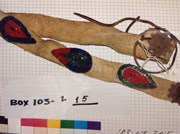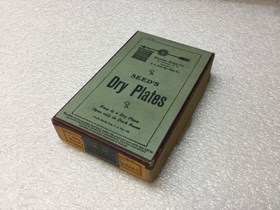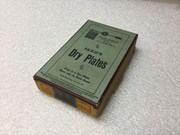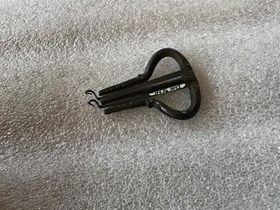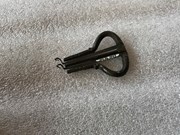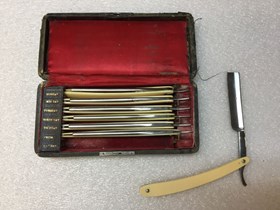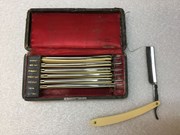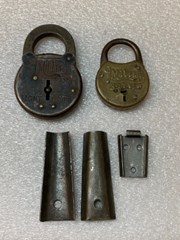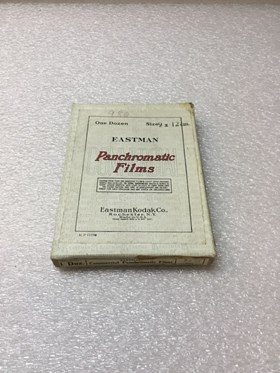Narrow Results By
- Date
- 1900 – 1920
- Material
- skin; glass
- Catalogue Number
- 103.07.3015
- Description
- Narrow buckskin belt with commercially prepared hide ties. Six beaded teardrop shapes in various colours sewn onto belt. Many pointed hide medallion at both ends.
1 image
- Title
- Beaded Belt
- Date
- 1900 – 1920
- Material
- skin; glass
- Dimensions
- 4.5 x 75.0 cm
- Description
- Narrow buckskin belt with commercially prepared hide ties. Six beaded teardrop shapes in various colours sewn onto belt. Many pointed hide medallion at both ends.
- Subject
- Indigenous
- regalia
- beadwork
- Credit
- Gift of Catharine Robb Whyte, O. C., Banff, 1979
- Catalogue Number
- 103.07.3015
Images
This material is presented as originally created; it may contain outdated cultural descriptions and
potentially offensive content.
Read more.
- Date
- c. 1910
- Material
- leather; metal; glass; wood; plastic; textile
- Catalogue Number
- 104.41.0249
- Description
- Buster Brown box camera with brown leather handle. Solid structure with black textile covering made to resemble leather. The front of the camera has a hole that likely once held a lens. There are two smaller holes in the upper corner of the front, which contain small glass parts. There is also meta…
1 image
- Title
- Box Camera
- Date
- c. 1910
- Material
- leather; metal; glass; wood; plastic; textile
- Dimensions
- 13.5 x 9.7 x 15.9 cm
- Description
- Buster Brown box camera with brown leather handle. Solid structure with black textile covering made to resemble leather. The front of the camera has a hole that likely once held a lens. There are two smaller holes in the upper corner of the front, which contain small glass parts. There is also metal hardware holding the front exterior panel to the structure. One side has a round hole with glass held by metal hardware, creating a viewfinder. There is also a metal winding mechanism, and a lever for the shutter release. The lever activates a mechanism that quickly uncovers and then re-covers the inner lens. The rear part of the camera has a small round, red-tinted window that would have shown the number for the section of film in position. At the top is a metal hinge that can be lifted to open the back panel, which comes down and is connected with a textile hinge. The top of the camera has a leather handle attached with metal pegs. The leather handle is worn, but you can see that it has been engraved by the manufacturer with the text: “No. 2A BUSTER BROWN”. There is also a viewfinder on the front corner. When the metal latch is opened, the rear panel opens and the interior cartridge can be seen. Pulling out the handle of the winding mechanism on the side of the camera releases the cartridge so that it can be removed. It’s a wooden box with a lens on the front and it has compartments for spools that hold the film. There is a spool in one side, but the other is empty. There are also two metal rollers that would hold the film in place. One side of the wooden cartridge is engraved with the following text: “MFD. BY”; “ANSCO COMPANY”; “BINGHAMTON, N.Y.”; “U.S.A.”; “PATENTED”; “JUNE 23 1903”; “SEPT. 20 1910”; “OTHER PAT. PENDING”; “FOR 6A OR 6B FILM”. Above the engraving is some handwriting in pencil that reads “6-A”; “2 1/2 x 4 1/2”. link to pdf of user manual: http://www.cameramanuals.org/agfa_ansco/ansco_buster_brown_camera.pdf
- Credit
- Gift of Don Harmon, Banff, 1985
- Catalogue Number
- 104.41.0249
Images
This material is presented as originally created; it may contain outdated cultural descriptions and
potentially offensive content.
Read more.
- Date
- 1902 – 1953
- Material
- metal
- Catalogue Number
- 103.09.1286
- Description
- Canadian Artillery cap badge inscribed “ Ubique Quo Fas et Glorioa Ducunt” Latin for “Everywhere Whither Right and Glory Lead” the mantra of the Artillery. Crowned with the Tudor Crown which was used pre 1953 and replaced by the Saint Edwards Crown on the authority of Queen Elizabeth II.
1 image
- Title
- Cap Badge Pin
- Date
- 1902 – 1953
- Material
- metal
- Dimensions
- 5 x 7 cm
- Description
- Canadian Artillery cap badge inscribed “ Ubique Quo Fas et Glorioa Ducunt” Latin for “Everywhere Whither Right and Glory Lead” the mantra of the Artillery. Crowned with the Tudor Crown which was used pre 1953 and replaced by the Saint Edwards Crown on the authority of Queen Elizabeth II.
- Credit
- Gift of Harold C. Whyte, Penticton, 2017
- Catalogue Number
- 103.09.1286
Images
This material is presented as originally created; it may contain outdated cultural descriptions and
potentially offensive content.
Read more.
Exposure Plates
https://archives.whyte.org/en/permalink/artifact104.41.0207
- Date
- 1902 – 1920
- Material
- cardboard; paper; glass;
- Catalogue Number
- 104.41.0207
- Description
- Box of one dozen 3 1/4 x 5 1/2 glass Seed’s Dry Plates with cut paper adhesive tape around the edges and bottom and manufacturer details printed on a pale green background throughout the lid. These dry plates were invented by M.A. Seed in 1879 and became very popular with photographers as the plate…
1 image
- Title
- Exposure Plates
- Date
- 1902 – 1920
- Material
- cardboard; paper; glass;
- Dimensions
- 3.0 x 9.3 x 15.0 cm
- Description
- Box of one dozen 3 1/4 x 5 1/2 glass Seed’s Dry Plates with cut paper adhesive tape around the edges and bottom and manufacturer details printed on a pale green background throughout the lid. These dry plates were invented by M.A. Seed in 1879 and became very popular with photographers as the plates came pre-prepared with the emulsion layer already applied - prior to “dry” plates, photographers would need portable dark rooms in which they would create their liquid emulsions prior to taking a photograph [known as “wet” plates]. Seed’s dry plates still required they be opened in a dark room, but this could be accomplished in the field by placing a dark sheet over the camera while loading and unloading the plates. In 1902, Eastman Kodak purchased Seed’s company [Seed Dry Plate Co.], but continued to capitalize on his name due to its reputation among consumers.
- Credit
- Gift of Robert Crosby Family, Banff, 1998
- Catalogue Number
- 104.41.0207
Images
This material is presented as originally created; it may contain outdated cultural descriptions and
potentially offensive content.
Read more.
Folding Camera
https://archives.whyte.org/en/permalink/artifact104.41.0245
- Date
- 1905 – 1927
- Material
- metal; leather; glass; wood
- Catalogue Number
- 104.41.0245
- Description
- A large, black leather bound square folding camera from Eastman Kodak Co. The camera when folded looks like a leather case with a leather handle attached at the top with two large metal buttons. One of the shorter sides features varying mechanisms to make adjustments to the camera. At the top is re…
1 image
- Title
- Folding Camera
- Date
- 1905 – 1927
- Material
- metal; leather; glass; wood
- Dimensions
- 24.6 x 23.0 x 10.0 cm
- Description
- A large, black leather bound square folding camera from Eastman Kodak Co. The camera when folded looks like a leather case with a leather handle attached at the top with two large metal buttons. One of the shorter sides features varying mechanisms to make adjustments to the camera. At the top is rectangular shaped metal plate with a knob that can be twisted and will make a clicking noise with a engraved arrowed to indicate turn the knob counter-clockwise, underneath is a l-shaped leaver that has a minor turn radius with an “M” engraved on the one arm. In the middle is a gold metal knob that can be pushed away from the case to open the one side and reveal the camera. Near the knob is a metal plate that reads “SPEED GRAPHIC CURTAIN APERTURE”, a graph with numbers, and “FOLMER & SCHWING DIVISION” “EASTMAN KODAK CO.” “13476 ROCHESTER, N.Y.” At the bottom is another square-shaped plate with a knob that can be turned that corresponds to numbers in a small black circle in the plate. On the top of the case is a white sticker with blue numbers “68622”. On the back of the case is a section for film holders/double dark slides and a glass plate behind a piece of the case that opens with a clasp at the bottom of the square. The other short side features small metal circles and a hole for a screw - most likely for a tripod mount. The front of the case is flat. When the case is opened it reveals the folded camera with black bellows and a silver metal face with a Wollensak Betax No.3 lens. It moves on a track to extend and retract with a mechanism in the front that when pinch together allows for the movement of the camera. There is a partially ripped sticker on the wood panel that reads “Sales - Service - Repairs” “Camera & Instrument Crafts” “9452 Calgary, Alta.” One side of the panel also features a black plate with numbers for focal range.
- Credit
- Gift of Don Harmon, Banff, 1985
- Catalogue Number
- 104.41.0245
Images
This material is presented as originally created; it may contain outdated cultural descriptions and
potentially offensive content.
Read more.
- Date
- 1900 – 1925
- Material
- wood
- Catalogue Number
- 104.20.0235
- Description
- Wooden fork with smoothly carved handle and knob at end. Cluster of four long sharp tines in square from knob carved at other end of handle.
1 image
- Title
- Fork
- Date
- 1900 – 1925
- Material
- wood
- Dimensions
- 2.4 x 1.9 x 30.9 cm
- Description
- Wooden fork with smoothly carved handle and knob at end. Cluster of four long sharp tines in square from knob carved at other end of handle.
- Credit
- Gift of Catharine Robb Whyte, O. C., Banff, 1979
- Catalogue Number
- 104.20.0235
Images
This material is presented as originally created; it may contain outdated cultural descriptions and
potentially offensive content.
Read more.
- Date
- 1900 – 1930
- Material
- metal
- Catalogue Number
- 104.36.0003
- Description
- Lyre shaped cast iron frame with a third cast iron leg from the top of the harp down the middle between the outer legs. A double, flat, flexible, thin, vibrating tongue passes down on either side of the central leg to the end of the harp where the ends turn up at sharp right angles, ending in wire …
1 image
- Title
- Jew's Harp
- Date
- 1900 – 1930
- Material
- metal
- Dimensions
- 2.2 x 5.6 x 6.9 cm
- Description
- Lyre shaped cast iron frame with a third cast iron leg from the top of the harp down the middle between the outer legs. A double, flat, flexible, thin, vibrating tongue passes down on either side of the central leg to the end of the harp where the ends turn up at sharp right angles, ending in wire like hooks. The flexible tongue tapers from .3 cm wide to less than .1 cm at the hooked end. A series of three small, shallow, notches in the middle of each outer leg on the under side.
- Subject
- Whyte home
- households
- entertainment
- pastime
- Annie White
- music
- sound
- song
- accessories
- equipment
- Credit
- Gift of Catharine Robb Whyte, O. C., Banff, 1979
- Catalogue Number
- 104.36.0003
Images
This material is presented as originally created; it may contain outdated cultural descriptions and
potentially offensive content.
Read more.
- Date
- 1900 – 1920
- Material
- leather; fabric; metal; plastic; wood;
- Catalogue Number
- 103.02.0150
- Description
- Hard leather box for days-of-the-week straight razors. The box has a hinged lid held closed with a small metal clasp and the interior is lined with red velvet. The razors sit in designated slots, some spaced on the right with small pieces of wood, with the days of the week embossed in gold on leath…
1 image
- Title
- Kit Razor
- Date
- 1900 – 1920
- Material
- leather; fabric; metal; plastic; wood;
- Dimensions
- 3.4 x 8.6 x 18.9 cm
- Description
- Hard leather box for days-of-the-week straight razors. The box has a hinged lid held closed with a small metal clasp and the interior is lined with red velvet. The razors sit in designated slots, some spaced on the right with small pieces of wood, with the days of the week embossed in gold on leather down the left-hand side. The razors themselves have plastic handles with [most likely] stainless steel blades that have a small decoration on the handle beside the blade with “R. SCHLAG N.Y.” etched on one side and “EXTRA FINE MADE IN GERMANY” on the other. Handle with care, razors are very sharp.
- Credit
- Gift of Robert Crosby Family, Banff, 1998
- Catalogue Number
- 103.02.0150
Images
This material is presented as originally created; it may contain outdated cultural descriptions and
potentially offensive content.
Read more.
- Date
- 1907 – 1920
- Material
- metal;
- Catalogue Number
- 102.04.0599 a-e
- Description
- Two metal Miller Lock Co. padlocks, one larger than the other, and three pieces of metal that serve an unknown purpose. The larger lock has the manufacturer details engraved along the curved arm, “MILLER” engraved in a decorative scroll on the body above the key hole, and “EIGHT LEVER” engraved bel…
1 image
- Title
- Padlock
- Date
- 1907 – 1920
- Material
- metal;
- Dimensions
- 1.1 x 6.2 x 9.4 cm
- Description
- Two metal Miller Lock Co. padlocks, one larger than the other, and three pieces of metal that serve an unknown purpose. The larger lock has the manufacturer details engraved along the curved arm, “MILLER” engraved in a decorative scroll on the body above the key hole, and “EIGHT LEVER” engraved below the key hole. The smaller lock has “MILLER” in a decorative scroll and “3-LEVER” engraved above the key hole. Both locks have several brass studs throughout the fronts and backs. The three extra metal pieces all have small holes drilled in them, two are longer and tapered at one end and curve in a semi-circle, the third is mostly flat with the two long sides folded up and towards the center and has a small hook at one short end.
- Subject
- locks
- protection devices
- Credit
- Gift of Bill Mather, Edmonton, 1991
- Catalogue Number
- 102.04.0599 a-e
Images
This material is presented as originally created; it may contain outdated cultural descriptions and
potentially offensive content.
Read more.
Panchromatic Film
https://archives.whyte.org/en/permalink/artifact104.41.0201
- Date
- 1906 – 1923
- Material
- cardboard; paper;
- Catalogue Number
- 104.41.0201
- Description
- One box of a dozen 9x12cm Eastman Commercial Panchromatic Films - unopened. The box has a large paper label on the lid containing the manufacturer and development details throughout, as well as “9.80” written in pencil at the top. The edges and bottom of the box are sealed with brown paper adhesive…
1 image
- Title
- Panchromatic Film
- Date
- 1906 – 1923
- Material
- cardboard; paper;
- Dimensions
- 1.5 x 10.0 x 13.7 cm
- Description
- One box of a dozen 9x12cm Eastman Commercial Panchromatic Films - unopened. The box has a large paper label on the lid containing the manufacturer and development details throughout, as well as “9.80” written in pencil at the top. The edges and bottom of the box are sealed with brown paper adhesive tape, the right-hand side is stamped with “DEVELOP BEFORE APRIL 1923.”Panchromatic film is a kind of black-and-white emulsion that is sensitive to all visible light wavelengths and creates realistic photographs - it could also be used successfully for colour and black-and-white motion pictures as early as 1913. One downside to panchromatic film was that it had to be developed in complete darkness as it was sensitive to the red lights standard in many darkrooms.
- Credit
- Gift of Robert Crosby Family, Banff, 1998
- Catalogue Number
- 104.41.0201
Images
This material is presented as originally created; it may contain outdated cultural descriptions and
potentially offensive content.
Read more.


